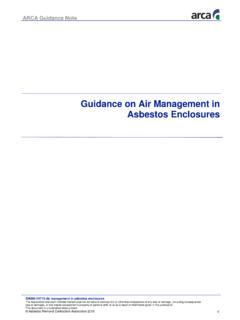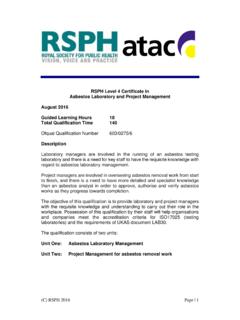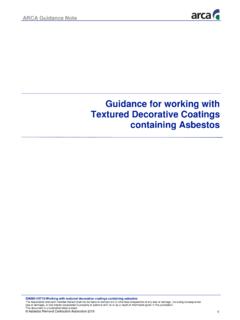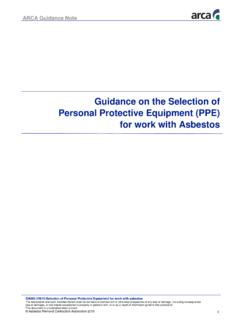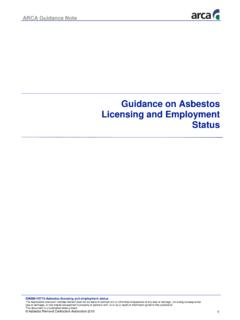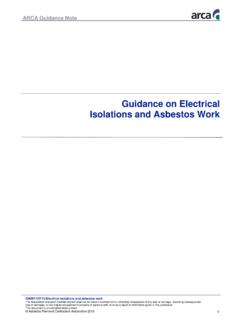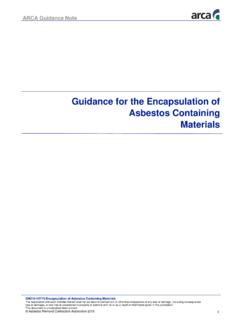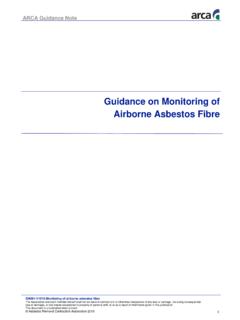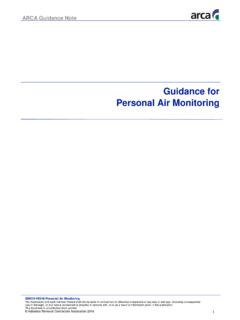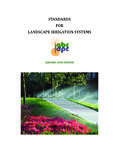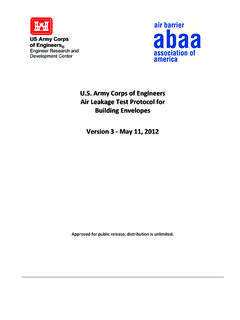Transcription of Guidance on Monitoring of Airborne Asbestos Fibre
1 1 GN001-V1015- Monitoring of Airborne Asbestos Fibre The Association and each member thereof shall not be liable in contract tort or otherwise irrespective of any loss or damage, (including consequential loss or damage), or any nature occasioned to property or persons with, to or as a result of information given in this publication. This document is uncontrolled when printed. Asbestos Removal Contractors Association 2015 ARCA Guidance Note Guidance on Monitoring of Airborne Asbestos Fibre 2 GN001-V1015- Monitoring of Airborne Asbestos Fibre The Association and each member thereof shall not be liable in contract tort or otherwise irrespective of any loss or damage, (including consequential loss or damage), or any nature occasioned to property or persons with, to or as a result of information given in this publication. This document is uncontrolled when printed. Asbestos Removal Contractors Association 2015 ARCA Guidance Note Guidance ON Monitoring OF Airborne Asbestos Fibre 1.
2 OBJECTIVE The objective of this Guidance note is to provide advice on both why and when it is appropriate to implement a programme to monitor Asbestos Fibre levels. 2. INTRODUCTION During work with Asbestos it is often necessary to carry out air Monitoring to assess the concentration of Airborne Asbestos Fibre levels that have been generated by the removal / remediation process. Air Monitoring in many instances is a legal requirement and the Control of Asbestos Regulations 2012 (CAR 2012) makes reference to air Monitoring in several of the Regulations, namely Regulation 19 (air Monitoring ), Regulation 20 (Standards for Air Testing and Site Clearance Certification) and Regulation 21 (Standards for Analysis). In addition the document Work with materials containing Asbestos (ACoP) which accompanies the Control of Asbestos Regulations 2012 (L143) makes reference to air Monitoring specifically in paragraphs 479-489. Air Monitoring may be carried out for the following reasons: To confirm that an appropriate level of personal protection has been chosen This can be achieved by undertaking personal sampling on the employees whilst work is being carried out.
3 To check the effectiveness of dust suppression methods The ACoP requires that air Monitoring should be used to demonstrate that control measures are effective in preventing exposure, or where this is not reasonably practicable keeping Asbestos Fibre levels as low as is reasonably practicable (regulations 11 and 16 of CAR 2012). Air Monitoring results from previous works of a similar nature can be used to assess likely exposures when compiling a risk assessment for future work. This type of Monitoring may also be appropriate to monitor the consistency and work practices of individual work teams, or when there is a change in the working method which may require reassessment. To provide data for employee exposure records Regulation 19 of CAR 2012 and the ACoP requires measurements to be obtained on a regular basis to establish employee exposure records as part of the operative s health record required by regulation 22. This Monitoring should be carried out by taking personal samples within the respiratory zone ( on the employee s lapel or shoulder).
4 To check that an area is suitable for re-occupation on completion of Asbestos work 3 GN001-V1015- Monitoring of Airborne Asbestos Fibre The Association and each member thereof shall not be liable in contract tort or otherwise irrespective of any loss or damage, (including consequential loss or damage), or any nature occasioned to property or persons with, to or as a result of information given in this publication. This document is uncontrolled when printed. Asbestos Removal Contractors Association 2015 ARCA Guidance Note The sampling is part of the 4-stage clearance process described in the ACoP and Asbestos : The analysts guide for sampling, analysis and clearance procedures (HSG 248). Note that clearance air sampling is also required in the dirty end and shower section of the hygiene facility (or mobile decontamination unit) before the unit is removed from site (for licensed Asbestos removal work only). 3. METHODOLOGY A measured volume of air is drawn through a 25mm diameter filter, which is examined under a microscope.
5 The respirable fibres on a measured area of the filter are counted using phase contrast optical microscopy (PCOM), and the concentration of the fibres in the air is calculated. The full method is described in detail within Appendix 1 of HSG 248. Fibre discrimination is both possible and allowed according to HSG 248, Appendix 1, Para which states that "fibres with widths greater than 1 um may show optical properties that are inconsistent with Asbestos and it is permissible to eliminate these fibres from the count .. Discrimination against non- Asbestos fibres should only take place after the initial total count". As with all analysis, discrimination is dependent on the techniques available and the skill of the microscopist. Polarised light microscopy (PLM), UV Fluorescence, SEM with Energy Dispersive X-Ray Analysis (EDXA), and TEM with EDXA and Selected Area Electron Diffraction are techniques recommended by MDHS 87. Whilst SEM and TEM both require half of the original filter to be sent for analysis, results can be achieved using PLM relatively quickly where a polariser and analyser are fitted to the phase contrast microscope.
6 A 1st order plate may also be beneficial. Using PLM in conjunction with PCOM, the morphology (PCOM, PLM), colour (PLM), pleochroism (PLM), birefringence (X-polars), angle of extinction (X-polars) and sign of elongation (1st order plate) for each Fibre may be recorded. Both the initial total count and the second discrimination count should be reported. MDHS 87 covers Fibre discrimination more thoroughly. 4. CONTROL LIMIT The control limit is specified in regulation 2 of CAR 2012 as fibres per cubic centimetre (f/cm3). This limit is not a sharp dividing line between a safe and a dangerous concentration. All Asbestos types are classified as Class 1 carcinogens by the World Health Organisation (WHO), therefore exposure should be prevented, or where this is not possible exposure should be kept as low as is practicable at all times. Where the control limit is, or is likely to be exceeded, there is a statutory requirement (regulation 11(2) of CAR 2012) for the employer to provide suitable Respiratory Protective Equipment (RPE) if exposure levels cannot be reduced by any other means, in order to reduce exposure to the lowest level as is reasonably practicable, and in any event to below the control limit.
7 4 GN001-V1015- Monitoring of Airborne Asbestos Fibre The Association and each member thereof shall not be liable in contract tort or otherwise irrespective of any loss or damage, (including consequential loss or damage), or any nature occasioned to property or persons with, to or as a result of information given in this publication. This document is uncontrolled when printed. Asbestos Removal Contractors Association 2015 ARCA Guidance Note For measurements relating to the control limit, personal sampling should be used. For clearance certification, reassurance, leak or background tests, static samples are usual. Samples taken need to be representative of work giving rise to the highest likely Fibre levels, a careful note of the work activity underway should be recorded and a sufficient sampling period should be used in order to achieve a meaningful result. For personal sampling, a sampling period of less than 1 hour is unlikely to be representative unless carefully justified.
8 There are potentially many reasons for carrying out air tests, but by far the most common is to check the Airborne Asbestos Fibre levels associated with Asbestos removal works. Air testing in this context is done for several reasons: Background Sampling It may be useful to establish the respirable Fibre concentrations prior to any activity which may lead to Airborne Asbestos contamination, to ensure that the risk is not being increased as a result of the activity. If Fibre levels are found to be elevated, prior to Asbestos works, consideration should be given to pre cleaning or extending the scope of works. If the contamination is not deemed to be Asbestos , this should be taken into consideration when assessing future air Monitoring results, such as leak tests. This type of test can also be carried out to check for Airborne fibres in situations where it is suspected that Asbestos fibres may have been released by accidental damage or inadvertent disturbance of Asbestos materials.
9 Leak (enclosure check) sampling This is performed outside the enclosure whilst Asbestos work is in progress to check that the environmental control systems are adequate. It is also used to verify that the works are properly contained and that Asbestos fibres are not being released into adjacent areas. This is of paramount importance if the adjacent areas are occupied during the works. Personal sampling Personal sampling results should be used as a major indicator of performance for licensed contractors. Personal sampling is carried out for a number of reasons: By comparison against past records in similar circumstances, sampling results can give assurance that the control measures being used are effective in minimising exposure to the lowest level reasonably practicable. This will also verify that the protection factor afforded by selected RPE is adequate for the Asbestos Fibre levels to which workers will be exposed. Results are essential to provide underpinning evidence for exposure record assumptions In general, results provide information to be considered when planning future assessments and planning.
10 Results need to be reviewed on the level of both individuals and teams to ensure that work methods are being carried out effectively. 5 GN001-V1015- Monitoring of Airborne Asbestos Fibre The Association and each member thereof shall not be liable in contract tort or otherwise irrespective of any loss or damage, (including consequential loss or damage), or any nature occasioned to property or persons with, to or as a result of information given in this publication. This document is uncontrolled when printed. Asbestos Removal Contractors Association 2015 ARCA Guidance Note Monitoring may also be carried out during certain low risk work to demonstrate that exposures are sporadic and of low intensity (ie do not exceed f/cm3 measured over a 10 minute period, see Regulation 3 (2) of CAR 2012 and paragraph 32 of the ACoP). In order to ensure that personal sampling is carried out correctly, it is essential that the removal contractors management team and analyst cooperate and jointly plan the personal Monitoring strategy.
